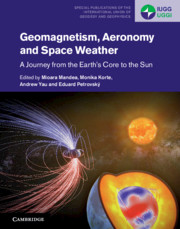Book contents
- Geomagnetism, Aeronomy and Space Weather
- Special Publications of the International Union of Geodesy and Geophysics Series
- Geomagnetism, Aeronomy and Space Weather
- Copyright page
- Contents
- Contributors
- Preface
- Part I Introduction
- Part II Geomagnetic Field
- 4 Geomagnetic Field Sources
- 5 Can Paleomagnetism Distinguish Dynamo Regimes?
- 6 Geomagnetic and Electromagnetic Observations at Ground Level
- 7 Modelling Internal and External Geomagnetic Fields Using Satellite Data
- 8 New Insights in Far-Space Measurements
- Part III Spatial and Temporal Variations of the Geomagnetic Field
- Part IV Space Weather
- Part V Magnetic Fields beyond the Earth and beyond Today
- Index
- References
4 - Geomagnetic Field Sources
From Earth’s Core to the Sun
from Part II - Geomagnetic Field
Published online by Cambridge University Press: 25 October 2019
- Geomagnetism, Aeronomy and Space Weather
- Special Publications of the International Union of Geodesy and Geophysics Series
- Geomagnetism, Aeronomy and Space Weather
- Copyright page
- Contents
- Contributors
- Preface
- Part I Introduction
- Part II Geomagnetic Field
- 4 Geomagnetic Field Sources
- 5 Can Paleomagnetism Distinguish Dynamo Regimes?
- 6 Geomagnetic and Electromagnetic Observations at Ground Level
- 7 Modelling Internal and External Geomagnetic Fields Using Satellite Data
- 8 New Insights in Far-Space Measurements
- Part III Spatial and Temporal Variations of the Geomagnetic Field
- Part IV Space Weather
- Part V Magnetic Fields beyond the Earth and beyond Today
- Index
- References
Summary
The geomagnetic field extending outward beyond Earth’s solid surface encounters a strong, highly variable flow of hot ionized gas from the Sun called the solar wind. This compresses and shapes the dayside of Earth’s magnetic field. On the night (anti-sunward) side of the Earth, the magnetic field gets drawn out into a long, comet-like tail. Present evidence is that this magnetotail region extends to hundreds or thousands of Earth radii. Research over the past six decades has revealed much about the various current systems that shape the Earth’s "magnetosphere". This chapter is devoted to providing a broad overview of the individual current systems that, acting together, generate the complex and fascinating geomagnetic field.
Keywords
- Type
- Chapter
- Information
- Geomagnetism, Aeronomy and Space WeatherA Journey from the Earth's Core to the Sun, pp. 41 - 47Publisher: Cambridge University PressPrint publication year: 2019



